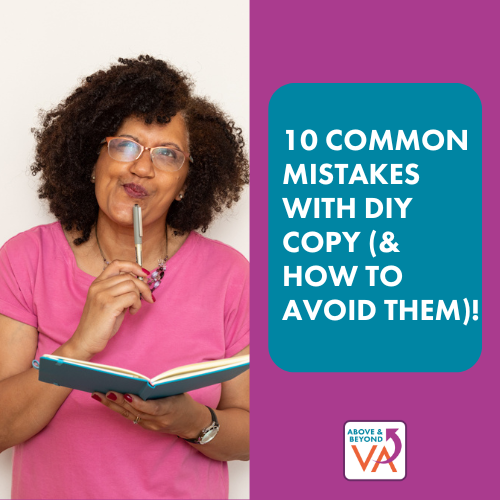If you’re a creative biz owner who’s ever dabbled in writing your own copy, you’ll know it can feel a bit like trying to play a guitar solo without knowing how to hold the guitar.
But first, let me be clear what *copy is.
[*I don’t mean to sound patronising but I’ve had many a blank stare when I tell people I’m a copywriter!]
Copy is all the words you write for your business, (whether it’s on your website, socials, emails), designed to nudge your potential clients to take action. But they need to be the RIGHT words.
Sure, you’ve got the passion to write your own copy, but when it comes to connecting with your audience, something’s just not hitting the right notes.
Don’t worry – you’re not alone! It happens to the best of us. I made pretty much ALL of these mistakes when I first started out cos you don’t know what you don’t know, right?
Here are 10 common mistakes business owners make with DIY copy (and how you can avoid them).
#1. Writing Like a Robot 🤖
You know the type – stiff, formal, and sounding like a legal contract. Customers want to connect with a person, not a jargon-spitting machine. You need to infuse some personality into your copy, making it sound like a conversation with a mate, not a monologue written by R2-D2 or copied and pasted from an AI bot like ChatGPT.
#2. Forgetting the Audience 🤷🏽
This one’s a biggie. Many business owners write copy that speaks to their own needs and goals, forgetting who the real star of the show is – your potential dream client. Your copy needs to talk directly to this person showing you understand where they’re coming from and not just blow your own trumpet. It’s about them, not you! And you really need to know your dream client to be able to write to them.
#3. Being Too Vague or Generic 🤔
How many times have you read copy that could apply to any business in any industry? “We provide excellent services that meet all your needs!” Great. But what does that even mean? Your copy needs to clearly articulate what you offer and why you’re the best option for your customer. Specifics, not fluff.
#4. Overloading with Features, Forgetting Benefits ☑️
Business owners often fall into the trap of listing features rather than explaining benefits. Customers don’t care if your widget has ten different modes. They care about how those modes are going to make their life easier and solve their problem. I hate to break it to you but your clients are only interested in what’s in it for them. Remember, features are cool, but benefits really seal the deal.
#5. Being Too Salesy 🤑
We’ve all seen it – copy that screams, “BUY NOW!” in your face, offering no substance. When you focus on the hard sell, you lose the potential customer’s trust. The key is to build a meaningful relationship through trust and value, not desperate sales tactics that send people running for the hills.
#6. Ignoring SEO (or Overstuffing Keywords) 🙈
Ah, SEO. The double-edged sword of copywriting. Either you don’t think about it at all and miss out on search engine traffic, or you go overboard and stuff keywords everywhere until your copy reads like gibberish. The trick? Balance. Keep it natural, but make sure your copy is SEO-friendly enough to be found.
#7. No Call to Action (or Too Many) 🙃
If you don’t tell your audience what to do next, guess what? They won’t do anything. But equally, too many calls to action will confuse them. You need to give a strong, clear and simple instruction, whether it’s “Buy now,” “Get in touch,” or “Learn more.”
#8. Focusing Too Much on Yourself 🥰
Your customers don’t really care about your company history or how many awards you’ve won. Harsh? Maybe. True? Definitely. They care about how you can help them. So, instead of filling your copy with “we” and “I,” shift the focus to the “you” language and show how you’re solving their problems.
#9. Overcomplicating the Language 🧐
Using fancy words doesn’t make you sound smarter – it makes your copy harder to read. Keep it simple and conversational. You’re not writing an academic paper or answering a GSCE exam question, you’re having a chat with your audience. If they have to whip out a dictionary, your copy’s doing more harm than good.
#10. Failing to Proofread 🖊️
Typos, grammar mistakes, and dodgy sentence structures can make even the best business look unprofessional. Proofreading isn’t just about catching mistakes – it’s about showing you care enough to get it right. Proofread, edit, then proofread again or better yet, get another pair of fresh eyes on it. Proofread like your business depends on it – because it does!
Struggling with DIY Copy?
If any of these mistakes sound familiar, you’re not alone. Writing your own copy can be tricky, especially when you’re juggling everything else in your business. But great copy is the difference between grabbing your clients’ attention and losing them to your competitors.
If you’re finding it tough to get your message across or you’re tired of guessing what works, drop me a line. I’m here to help you turn your ideas into copy that connects, converts, and feels as professional as your business deserves.
Let’s chat and make sure your words are working just as hard as you are. Your words represent your brand – make them count!

